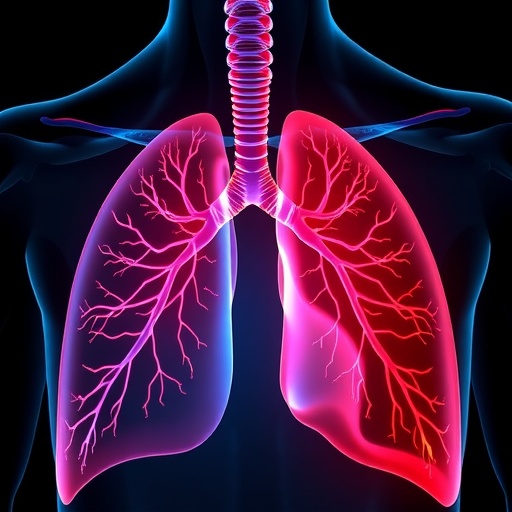A groundbreaking observational study recently published in the Journal of Thoracic Disease has shed new light on the efficacy and safety of pleurodesis—a procedure often employed to manage malignant pleural effusion (MPE)—in a highly vulnerable patient population: lung cancer patients complicated by interstitial lung disease (ILD). This research represents a significant stride in thoracic oncology and pulmonology, presenting nuanced insights into treatment strategies that balance therapeutic benefits with substantial risks.
Malignant pleural effusion, a condition characterized by the pathological accumulation of fluid in the pleural space due to malignancy, frequently complicates the clinical course of lung cancer. Its development exacerbates respiratory symptoms and severely diminishes quality of life. Pleurodesis, a therapeutic intervention aimed at obliterating the pleural space to prevent recurrent effusion, commonly involves chemical agents such as talc or minocycline to induce pleural inflammation and fibrosis. Although widely accepted in patients without ILD, the treatment’s safety profile and success rate in the presence of ILD are not well understood due to the intrinsic risks associated with the latter’s fragile pulmonary microenvironment.
This new observational study ambitiously tackles this clinical conundrum by analyzing pleurodesis outcomes specifically in lung cancer patients afflicted with ILD. The researchers meticulously excluded cases where the lung was only partially expanded before the procedure, acknowledging that incomplete lung expansion predicts pleurodesis failure. This methodological precision allowed the team to isolate and assess the true efficacy and safety of pleurodesis in a relatively homogeneous patient cohort.
The study’s findings offer cautious optimism: the pleurodesis efficacy rate hovered around 70%, consistent with rates reported in the general lung cancer population without ILD. This revelation challenges preconceived notions that ILD severely compromises the outcomes of pleurodesis and provides a potential therapeutic avenue for symptom relief in this complex interplay of diseases. However, the devil lies in the details. Despite comparable efficacy, the safety aspect unveiled a sobering caveat—two patients developed acute respiratory distress syndrome (ARDS), a life-threatening complication, following pleurodesis.
A striking observation from this research is the apparent link between prior systemic prednisolone treatment and ARDS development post-pleurodesis. Specifically, patients who had been treated with systemic steroids for ILD within six months prior to pleurodesis and who exhibited radiographic evidence of ground glass opacities and consolidation appeared to be at heightened risk. This correlation suggests that steroid-induced immunomodulation or preexisting pulmonary inflammation could predispose patients to severe inflammatory responses after pleurodesis, warranting meticulous patient selection and risk stratification.
Clinically, these insights bear immense weight. Pleurodesis remains a potentially valuable palliative option for lung cancer patients with secondary MPE complicated by ILD, offering symptom relief and potentially improving quality of life. Nonetheless, the lurking threat of ARDS, especially in the subset of steroid-treated patients with active radiographic disease, calls for heightened clinical vigilance. Physicians need to weigh the therapeutic advantages against the possibility of catastrophic lung injury, considering alternative management strategies for high-risk individuals.
From a pathophysiological standpoint, the development of ARDS following pleurodesis underscores the delicate balance within the pulmonary microenvironment in ILD patients. Pleurodesis-induced inflammation, intended to seal the pleural space, can inadvertently trigger an exaggerated immune cascade in compromised lungs, culminating in diffuse alveolar damage. The pre-existence of radiographic abnormalities such as ground glass opacity reflects ongoing alveolar inflammation or fibrosis, which may prime the lungs for this maladaptive response.
The choice of sclerosing agent also necessitates scrutiny. Talc, while effective, has been historically linked with ARDS due to its potential to provoke systemic inflammatory responses, especially when particle size distribution is not controlled. Minocycline, an antibiotic with anti-inflammatory properties, offers an alternative, yet its comparative risk profile in ILD populations remains under-explored. This study, utilizing either talc or minocycline, highlights the need for further randomized trials to delineate the optimal agent for pleurodesis in such complex cases.
Beyond immediate therapeutic implications, the study amplifies the call for integrated care approaches encompassing multidisciplinary teams including pulmonologists, oncologists, and radiologists. Meticulous pre-procedural imaging assessment, comprehensive evaluation of ILD activity, and careful review of recent steroid use should be prerequisites before deciding on pleurodesis. Such personalized medicine paradigms will help mitigate risks and optimize outcomes for patients navigating the treacherous terrain of lung cancer and interstitial lung disease.
This investigative endeavor also opens the door for future research into biomarkers that might predict which patients are at risk for adverse events post-pleurodesis. Identifying molecular signatures or inflammatory profiles that predispose to ARDS could revolutionize patient selection and pave the way for prophylactic interventions. Furthermore, innovations in pleurodesis techniques, including the exploration of novel sclerosing agents with improved safety profiles, are warranted to enhance therapeutic indices.
In conclusion, this study embodies a critical advancement in the management of malignant pleural effusion among lung cancer patients complicated with interstitial lung disease. It balances hope with caution, affirming pleurodesis as a viable palliative intervention while highlighting the profound risks in certain clinical scenarios. The nuanced findings serve as a clarion call for individualized treatment strategies, rigorous clinical judgment, and ongoing research to optimize patient outcomes in this challenging clinical intersection.
Subject of Research: People
Article Title: Efficacy and safety of pleurodesis for lung cancer patients with interstitial lung disease
News Publication Date: 27-Feb-2025
Web References: http://dx.doi.org/10.21037/jtd-24-1541
References: Iso H, Miyanaga A, Sato Y, Shirakura Y, Shinbu K, Inoue T, Nagano A, Misawa K, Tozuka T, Murata A, Higa K, Takeuchi S, Matsumoto M, Kamio K, Kasahara K, Seike M. Efficacy and safety of pleurodesis for lung cancer patients with interstitial lung disease. J Thorac Dis 2025;17(2):687-694. doi: 10.21037/jtd-24-1541
Keywords: Lung cancer, Malignant pleural effusion, Interstitial lung disease, Pleurodesis, Talc, Minocycline, Acute respiratory distress syndrome, Systemic steroids, Pulmonary fibrosis, Thoracic oncology




